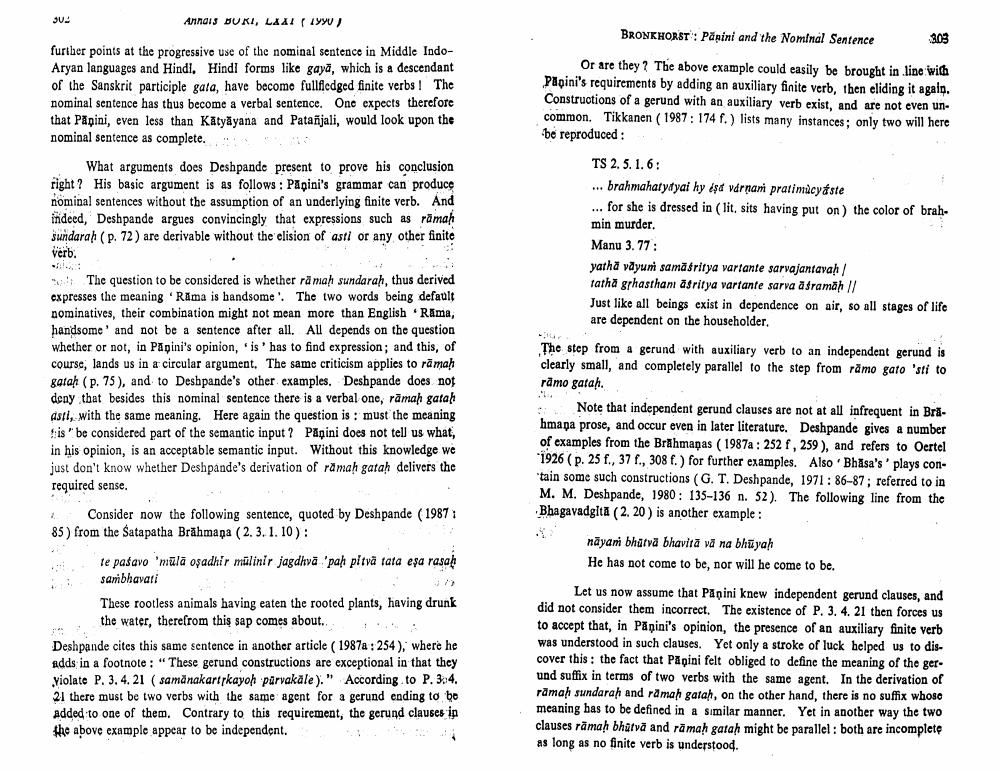Book Title: Panini And Nominal Sentence Author(s): Johannes Bronkhorst Publisher: Johannes Bronkhorst View full book textPage 2
________________ 30.4 Anndis DURI, LAAT ( 19 ) BRONKHORST : Papini and the Nominal Sentence 303 further points at the progressive use of the nominal sentence in Middle IndoAryan languages and Hindi. Hindi forms like gaya, which is a descendant of the Sanskrit participle gata, have become fullfledged finite verbs! The nominal sentence has thus become a verbal sentence. One expects therefore that Papini, even less than Katyāyana and Patanjali, would look upon the nominal sentence as complete. " What arguments does Deshpande present to prove his conclusion right? His basic argument is as follows: Papini's grammar can produce nominal sentences without the assumption of an underlying finite verb. And indeed, Deshpande argues convincingly that expressions such as ramah sundarah (p. 72 ) are derivable without the elision of asti or any other finite Or are they? The above example could easily be brought in line with Plqini's requirements by adding an auxiliary finite verb, then eliding it again. Constructions of a gerund with an auxiliary verb exist, and are not even uncommon. Tikkanen (1987: 174 f.) lists many instances; only two will here be reproduced : TS 2.5.1. 6: ... brahmahatydyal hy est varnani pratimacy ste ... for she is dressed in (lit, sits having put on the color of brahmin murder. Manu 3.77: yatha vayuni samasritya vartante sarvajantavah/ tarha grhasthani asritya variante sarva asramah // Just like all beings exist in dependence on air, so all stages of life are dependent on the householder. verb. The question to be considered is whether rå mah sundarah, thus derived expresses the meaning 'Rama is handsome'. The two words being default nominatives, their combination might not mean more than English Rama, handsome' and not be a sentence after all. All depends on the question whether or not, in Papini's opinion, 'is' has to find expression; and this, of course, lands us in a circular argument. The same criticism applies to ramah gatah (p. 75), and to Deshpande's other examples. Deshpande does not deny that besides this nominal sentence there is a verbal one, ramah gatah asil, with the same meaning. Here again the question is: must the meaning is be considered part of the semantic input? Papini does not tell us what, in his opinion, is an acceptable semantic input. Without this knowledge we just don't know whether Deshpande's derivation of ramah gatah delivers the required sense. Consider now the following sentence, quoted by Deshpande (1987 85) from the Satapatha Brāhmaṇa ( 2.3.1. 10): te pasavo 'mala opadhir mülinir jagdhva 'pah pitvå fata esa rasah sambhavari These rootless animals having eaten the rooted plants, having drunk the water, therefrom this sap comes about. Deshpande cites this same sentence in another article (1987a : 254), where he adds in a footnote: "These gerund constructions are exceptional in that they violate P. 3. 4.21 (samanakart kayoh parvakale)." According to P. 3.4. 21 there must be two verbs with the same agent for a gerund ending to be added to one of them. Contrary to this requirement, the gerund clauses in the above example appear to be independent. The step from a gerund with auxiliary verb to an independent gerund is clearly small, and completely parallel to the step from ramo gato 'sti to ramo gatah. Note that independent gerund clauses are not at all infrequent in Brihmana prose, and occur even in later literature. Deshpande gives a number of examples from the Brāhmaṇas (1987a : 252 f, 259), and refers to Oertel *1926 (p. 25 f., 37, 308 P.) for further examples. Also Bhasa's' plays contain some such constructions (G. T. Deshpande, 1971: 86-87; referred to in M. M. Deshpande, 1980: 135-136 n. 52). The following line from the Bhagavadgita (2.20) is another example: nāyani bharva bhavita vd na bhiyah He has not come to be, nor will he come to be. Let us now assume that Panini knew independent gerund clauses, and did not consider them incorrect. The existence of P. 3. 4. 21 then forces us to accept that, in Papini's opinion, the presence of an auxiliary finite verb was understood in such clauses. Yet only a stroke of luck helped us to discover this: the fact that Pagini felt obliged to define the meaning of the ger. und suffix in terms of two verbs with the same agent. In the derivation of ramah sundarah and ramah gatah, on the other hand, there is no suffix whoso meaning has to be defined in a similar manner. Yet in another way the two clauses rāmah bhatva and ramah gatah might be parallel : both are incomplete as long as no finite verb is understood.Page Navigation
1 2 3
